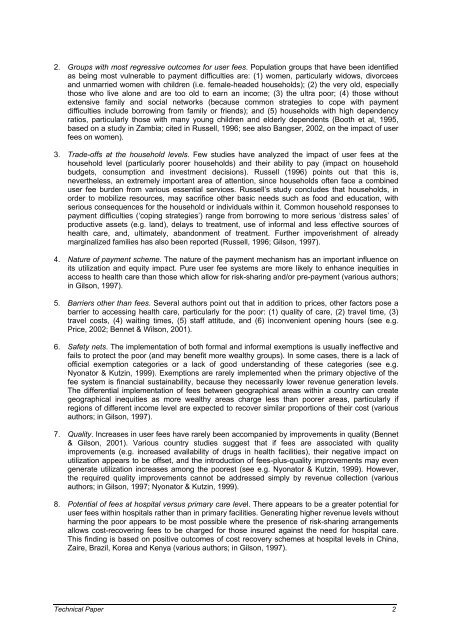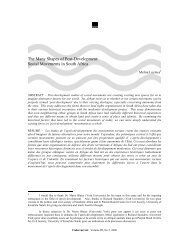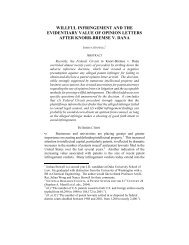equity implications of health sector user fees in tanzania
equity implications of health sector user fees in tanzania
equity implications of health sector user fees in tanzania
Create successful ePaper yourself
Turn your PDF publications into a flip-book with our unique Google optimized e-Paper software.
2. Groups with most regressive outcomes for <strong>user</strong> <strong>fees</strong>. Population groups that have been identified<br />
as be<strong>in</strong>g most vulnerable to payment difficulties are: (1) women, particularly widows, divorcees<br />
and unmarried women with children (i.e. female-headed households); (2) the very old, especially<br />
those who live alone and are too old to earn an <strong>in</strong>come; (3) the ultra poor; (4) those without<br />
extensive family and social networks (because common strategies to cope with payment<br />
difficulties <strong>in</strong>clude borrow<strong>in</strong>g from family or friends); and (5) households with high dependency<br />
ratios, particularly those with many young children and elderly dependents (Booth et al, 1995,<br />
based on a study <strong>in</strong> Zambia; cited <strong>in</strong> Russell, 1996; see also Bangser, 2002, on the impact <strong>of</strong> <strong>user</strong><br />
<strong>fees</strong> on women).<br />
3. Trade-<strong>of</strong>fs at the household levels. Few studies have analyzed the impact <strong>of</strong> <strong>user</strong> <strong>fees</strong> at the<br />
household level (particularly poorer households) and their ability to pay (impact on household<br />
budgets, consumption and <strong>in</strong>vestment decisions). Russell (1996) po<strong>in</strong>ts out that this is,<br />
nevertheless, an extremely important area <strong>of</strong> attention, s<strong>in</strong>ce households <strong>of</strong>ten face a comb<strong>in</strong>ed<br />
<strong>user</strong> fee burden from various essential services. Russell’s study concludes that households, <strong>in</strong><br />
order to mobilize resources, may sacrifice other basic needs such as food and education, with<br />
serious consequences for the household or <strong>in</strong>dividuals with<strong>in</strong> it. Common household responses to<br />
payment difficulties (‘cop<strong>in</strong>g strategies’) range from borrow<strong>in</strong>g to more serious ‘distress sales’ <strong>of</strong><br />
productive assets (e.g. land), delays to treatment, use <strong>of</strong> <strong>in</strong>formal and less effective sources <strong>of</strong><br />
<strong>health</strong> care, and, ultimately, abandonment <strong>of</strong> treatment. Further impoverishment <strong>of</strong> already<br />
marg<strong>in</strong>alized families has also been reported (Russell, 1996; Gilson, 1997).<br />
4. Nature <strong>of</strong> payment scheme. The nature <strong>of</strong> the payment mechanism has an important <strong>in</strong>fluence on<br />
its utilization and <strong>equity</strong> impact. Pure <strong>user</strong> fee systems are more likely to enhance <strong>in</strong>equities <strong>in</strong><br />
access to <strong>health</strong> care than those which allow for risk-shar<strong>in</strong>g and/or pre-payment (various authors;<br />
<strong>in</strong> Gilson, 1997).<br />
5. Barriers other than <strong>fees</strong>. Several authors po<strong>in</strong>t out that <strong>in</strong> addition to prices, other factors pose a<br />
barrier to access<strong>in</strong>g <strong>health</strong> care, particularly for the poor: (1) quality <strong>of</strong> care, (2) travel time, (3)<br />
travel costs, (4) wait<strong>in</strong>g times, (5) staff attitude, and (6) <strong>in</strong>convenient open<strong>in</strong>g hours (see e.g.<br />
Price, 2002; Bennet & Wilson, 2001).<br />
6. Safety nets. The implementation <strong>of</strong> both formal and <strong>in</strong>formal exemptions is usually <strong>in</strong>effective and<br />
fails to protect the poor (and may benefit more wealthy groups). In some cases, there is a lack <strong>of</strong><br />
<strong>of</strong>ficial exemption categories or a lack <strong>of</strong> good understand<strong>in</strong>g <strong>of</strong> these categories (see e.g.<br />
Nyonator & Kutz<strong>in</strong>, 1999). Exemptions are rarely implemented when the primary objective <strong>of</strong> the<br />
fee system is f<strong>in</strong>ancial susta<strong>in</strong>ability, because they necessarily lower revenue generation levels.<br />
The differential implementation <strong>of</strong> <strong>fees</strong> between geographical areas with<strong>in</strong> a country can create<br />
geographical <strong>in</strong>equities as more wealthy areas charge less than poorer areas, particularly if<br />
regions <strong>of</strong> different <strong>in</strong>come level are expected to recover similar proportions <strong>of</strong> their cost (various<br />
authors; <strong>in</strong> Gilson, 1997).<br />
7. Quality. Increases <strong>in</strong> <strong>user</strong> <strong>fees</strong> have rarely been accompanied by improvements <strong>in</strong> quality (Bennet<br />
& Gilson, 2001). Various country studies suggest that if <strong>fees</strong> are associated with quality<br />
improvements (e.g. <strong>in</strong>creased availability <strong>of</strong> drugs <strong>in</strong> <strong>health</strong> facilities), their negative impact on<br />
utilization appears to be <strong>of</strong>fset, and the <strong>in</strong>troduction <strong>of</strong> <strong>fees</strong>-plus-quality improvements may even<br />
generate utilization <strong>in</strong>creases among the poorest (see e.g. Nyonator & Kutz<strong>in</strong>, 1999). However,<br />
the required quality improvements cannot be addressed simply by revenue collection (various<br />
authors; <strong>in</strong> Gilson, 1997; Nyonator & Kutz<strong>in</strong>, 1999).<br />
8. Potential <strong>of</strong> <strong>fees</strong> at hospital versus primary care level. There appears to be a greater potential for<br />
<strong>user</strong> <strong>fees</strong> with<strong>in</strong> hospitals rather than <strong>in</strong> primary facilities. Generat<strong>in</strong>g higher revenue levels without<br />
harm<strong>in</strong>g the poor appears to be most possible where the presence <strong>of</strong> risk-shar<strong>in</strong>g arrangements<br />
allows cost-recover<strong>in</strong>g <strong>fees</strong> to be charged for those <strong>in</strong>sured aga<strong>in</strong>st the need for hospital care.<br />
This f<strong>in</strong>d<strong>in</strong>g is based on positive outcomes <strong>of</strong> cost recovery schemes at hospital levels <strong>in</strong> Ch<strong>in</strong>a,<br />
Zaire, Brazil, Korea and Kenya (various authors; <strong>in</strong> Gilson, 1997).<br />
Technical Paper 2













